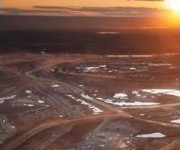Cross-posted from Climate Progress.
Extraction of Alberta’s energy-intensive tar sands has expanded steadily in recent years, with about 232 square miles now exposed by mining operations. Tar-sands production is expected to double over the next decade, which could mean the destruction of 740,000 acres of boreal forest and a 30-percent increase in carbon emissions from Canada’s oil and gas sector.
New satellite images show the dramatic expansion that has taken place from 2001 through 2011:
Photos: Robert Simmon, NASA/Landsat/USGS
So what’s the actual impact on the ground? Here’s what happens when you turn a carbon sink like the Boreal Forest into a carbon-spewing pit of tar sands:
Photos: Peter Essick, National Geographic


